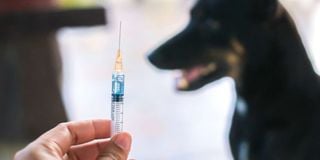War against rabies gets shot in the arm in new vaccination method

Rabies currently occurs in more than 150 countries and territories.
What you need to know:
- The door-to-door vaccination approach ensures high uptake, but is costly, says expert.
- During vaccination trials in Malawi, this method was able to highlight areas of low vaccination uptake.
- Rabies is a zoonotic, viral disease which can be prevented through vaccines.
The odds of winning the fight against rabies are set to skyrocket following the unveiling of a new smart phone technology.
The new approach towards dog vaccination is set to spot areas of low coverage in real time, allowing for increased and faster immunisation.
This technology was designed by researchers from the University of Edinburgh, UK. It was deployed for final trials in Malawi, and its findings were published in the journal Proceedings of the National Academy of Sciences.
The new method could present a shift from the traditional form of dog vaccination that is carried out door to door. “The door-to-door vaccination approach ensures high uptake, but is costly and consuming compared to the drop-in approach,” said Dr Stella Mazeri, a veterinary epidemiologist, who led the team of researchers.
Dr Mazeri and her team have revised the efficiency of the drop-in approach by creating a mobile application with the World Veterinary Service that allows the recording of data on vaccination and improves access to high-risk areas via GPS.
During vaccination trials in Malawi, this method was able to highlight areas of low vaccination uptake and facilitate the deployment of mobile vaccination clinics and mobile drop-in centres. Within 11 days, up to 35,000 animals had been vaccinated.
Human rabies
This was the same number that took up to three weeks to vaccinate using the door-to-door approach. “Delivering vaccination against rabies to at-risk populations in a highly efficient way has remained a major challenge until now. Real time interrogation of data can now allow for the improvement of the efficiency of vaccination methods, clinics, and targeted areas,” said Dr Mazeri.
Rabies is a zoonotic, viral disease which can be prevented through vaccines. The disease currently occurs in more than 150 countries and territories. The incubation period for rabies is usually two to three months. However, this may vary from one week to one year.
“Annual vaccination of at least 70 per cent of the dog population has been shown to be highly effective at reducing incidence of rabies in both human and dog populations. Almost all human rabies cases are caused by bites from rabies-infected dogs,” said Dr Mazeri.
According to World Health Organization and the World Animal Protection, by 2020, Kenya was recording up to 75,000 dog bites every year. Out of these, 500 to 1,000 dog bites resulted in death.
Globally, the World Organization for Animal Health estimates that about 59,000 lives are lost to rabies every year. About 40 per cent of these victims are children, the majority of whom are in underdeveloped countries.
Currently, researchers estimate that more than 1 million people will die from rabies globally between 2020 and 2035 if vaccination rates and immediate treatment for dog bites are not scaled upwards.
